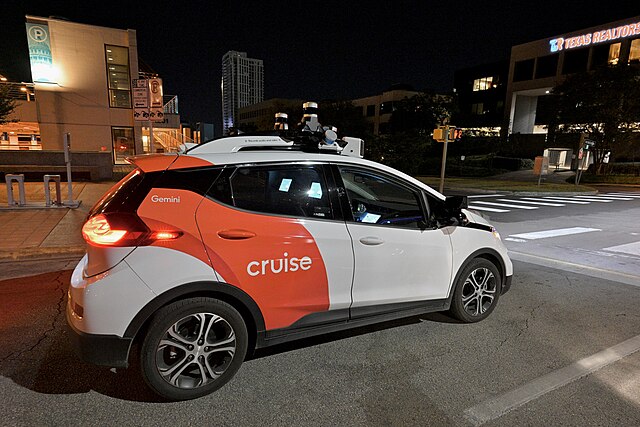
Maxx@night from Austin, Texas. USA. Creative Commons Attribution 2.0 Generic
The Cruise Bolt
Cruise is testing the use of autonomous vehicles (AVs) as a taxi service in Dallas, Houston, and Phoenix. Cruise Bolts are retrofitted Chevrolet Bolts. An AV is an assistive technology: it does not have the usual physical requirements for driving. People with many different disabilities could benefit from an AV service (their own or a hired vehicle).
Cruise and Accessibility
The Cruise website has two pages that discuss the Cruise AV’s accessibility features. The “Accessibility Statement” at the bottom of the page is actually Cruise’s “Website and Technology Accessibility Statement.” To get to the accessibility page about the Cruise Bolt itself, you have to either use the company’s search function or another search party. Each page has slightly different text, providing slightly different information. Given the information could be critical as to whether people can use the service, this setup is not ideal.

Accessibility Feature: Deaf/hard-of-hearing support
Cruise Support can communicate with a phone’s real-time texting feature through the Cruise app. This allows people who are hard of hearing to be able to access service on their own, which represents the functional model. In a similar vein, messages updating the user about the ride are on screens and announced through the car’s speakers. These allow a wider range of users to access the Cruise service.
Accessibility Feature: Blindness and low vision support
Service animals are permitted in Cruise Bolts without further charges, meaning that those who use a service animal are not financially penalized for using their service animal. This speaks to the higher costs that people with disabilities can experience (economic model) .
The Cruise mobile app works a phone’s “native screen reader.” According to Cruise, regular testing of the service and the app is done in conjunction with the National Federation of the Blind and the American Council of the Blind. Screen readers can be seen through the functional model by allowing a person with low vision the ability to use the Cruise service and its app on their own with just a phone. In addition, allowing people with vision disabilities to be able to use a car service affords them greater mobility, which breaks social barriers (social model) and, potentially, grants greater economic earning potential (economic model).
Accessibility Feature: Wheelchair Use
The Cruise Bolt does not feature wheelchair adaptations that allow a person to sit in the car in their wheelchair. Instead, currently, a person who uses a wheelchair has to be “comfortable transferring” – but that information is only available on one of the two accessible information pages. Here, we see that the social model of disability applies. Poor design in cars—which require expensive retrofitting to make them more accessible—mean that a person in a wheelchair cannot get into this car. The “solution” is for the person to transfer themself and place the wheelchair, so long as it’s an acceptable size, to ride along with them. This might well mean that a person with a wheelchair cannot use the Cruise Bolt at all or, perhaps, could only use it if with a person physically capable of helping them transfer.. (Cruise says it’s creating a Wheelchair Accessible Vehicle.)


This seems particularly egregious given that one of the photos on the carousel at the top of the homepage shows a person in a wheelchair and with a ramp, which implies the Cruise Bolt is fully wheelchair accessible.

Overall, the Cruise Bolt has potential and some good accessibility features, but a long way to go to be fully accessible for people with a wider range of disabilities.
References